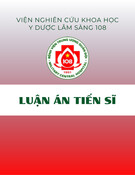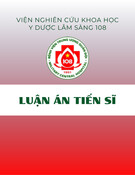MINISTRY OF EDUCATION AND TRAINING
VIETNAM ACADEMY OF SCIENCE AND TECHNOLOGY
GRADUATE UNIVERSITY SCIENCE AND TECHNOLOGY ----------------------------
SONEXAY XAYHEUNGSY PROJECT NAME: ASSESSMENT OF NATURAL
RADIOACTIVITY IN SOME BUILDING MATERIALS
USED IN LAOS PDR
Major: ATOMIC AND NUCLEAR PHYSICS
Code: 9440106
SUMMARY OF DOCTORAL THESIS OF MATERIALS SCIENCE
HANOI - 2019
The doctoral thesis was completed at Institute of Physics, Graduate University of Science and Technology
Supervisors: Prof. Dr. Le Hong Khiem Reviewer 1: …………………… Reviewer 2: …………………… Reviewer3: ……………………
This doctoral thesis will be defensed at Graduate University of Science and Technology, Vietnam Academy of Science and Technology on … hour…, date…. month … year…
The dissertation can be referred at: National Library of Vietnam
LIST OF PUBLISTIONS 1. Sonexay Xayheungsy, Le Hong Khiem. Measurement of natural radioactivity in some cements of Lao PDR by using NaI(Tl) gamma-ray spectrometer, Advance in applied and engineering Physics IV, Publishing House for Science and Technology,2016, 231
2. Sonexay Xayheungsy, Le Hong Khiem, Phương pháp xác định hoạt độ của các nguyên tố phóng xạ tự nhiên bằng phổ kế gamma dùng detector NaI(Tl), Advance In Applied And Engineering Physics V, Publishing House for Science and Technology, 2018, 295
3. S. Xayheungsy, L.H. Khiem, L.D. Nam, Radiation dose estimation of cement samples used in Lao PDR, Communications in Physics, 27, No. 3, 2017,193-203. 4. Sonexay Xayheungsy, Le Hong Khiem, Le Dai Nam. Assessment Of The Natual Radioactivity And Radiological Hazards In Lao Cement Samples. Radiation Protection Dosimetry, 2018, Vol. 181, No. 3, 208–213.
5. Sonexay Xayheungsy, Le Hong Khiem. Natural Radioactivity In The Soil Of Thoulakhom District In Vietiane Province, LaoPDR, Tạp Chí Phát Triển Khoa Học Và Công Nghệ- Đại Học Quốc Gia TP. HCM, ngày 21 tháng 3 năm 2018. 6. X.Sonexay, L.H.Khiem, L.D.Nam, Assessment of Natural Radioactivity Levels and Radiation Hazards of Building Materials of Lao PDR. International Journal Of Modern Engineering Research (IJMER), 14.04.2018 7. Sonexay Xayheungsy1,3, N.C.Thanh2, L.D.Nam2, V.H.Giang2 and
L.H.Khiem2,3*, Measurement of natural radioactivity in some sand and brick in Vietiane province, Lao PDR. IJRDO - Journal of Applied Science, Volume-4, Issue, 11, Nov, 2018.
INTRODUCTION 1. Thesis necessity
There are various sources that contain radiation, especially in the earth, rocks with different amounts. An amount of radiation that is higher than the safety threshold can be a cause of many diseases including cancer, which is dangerous for people.
Building materials such as cement, brick, sand, soil, etc. are mainly made from raw materials such as soil and rock. As a result, they can break down into radioactive gas radon. According to statistics of the UN, a person spends 70% his lifetime in-door (houses, offices, or public buildings, etc.). If the construction materials contain an extremely high amount of radiation, it will be hazardous.
For the safety of humankind, The United Nations Scientific Committee on the Effects of Atomic Radiation (UNSCEAR) has given a radiation safety threshold for building materials. In most countries, it is mandatory to check radioactivity of the materials for construction before they are used. In Laos PDR , up to now there has not been any inspection of radiation carried out (due to lack of skilled personnel).
Laos has officially become a member of the IAEA since 2011. Since then, Lao government have requested Vietnam to give a hand in training highly qualified personnel in the field of radioactive control in construction materials. The objective of this thesis is to understand the method of assessment of natural radioactivity in some building materials for better implementation of constructions in Laos. 2. Objectives of the study
The objectives of the thesis is: - Determination of the concentration of the Naturally Occurring Radioactive Materials (NORM) in some building materials commonly used in Lao PDR such as cement, sand, etc. by gamma spectrometers using NaI(Tl) and HPGe detectors. - To assess the radiological hazard associated with the natural occurring radioactive isotopes in the building materials used in Laos PDR.
These data are extremely important for the radiation dose assessment for residents, and making proper warning and necessary recommendations to production facilities so that they can make necessary adjustments to ensure the absolute safety in radioactive aspects for construction materials used in the market. 3. Main research contents of the thesis
- The research is to analyze the amount of concentration of natural occurring radioactive isotopes including 238U, 235U, 232Th and 40K in the building materials used in Laos PDR by using gamma-ray spectroscopy technique. For our measurements, both NaI(Tl) and HPGe detectors have been used for gamma-ray detection.
- For analyzing the gamma-ray spectra obtained with NaI(Tl) detector, a mathematical method has been used for determining the areas of overlapping spectral regions due to the poor energy resolution of NaI(Tl) detector.
- To evaluate the radiological hazard of the natural radioactivity, the radium equivalent activity, the air absorbed dose rate, the annual effective dose rate, the representative index and the values of both external and internal hazard indices
1
have been calculated based on obtained concentration of the natural occurring radioactive isotopes of the investigated of the building materials.
- Several computer programs have been developed for automatic analysis of gamma-ray spectra obtained with NaI(Tl), HPGe detectors and for routinely determining the values of the quantities related to radiological hazard due to the natural occurring radioactive isotopes in the building materials.
CHAPTER 1. OVERVIEW OF NORM IN BUILDING MATERIAL
1.1. Origin of natural radiation and its connection to building materials 1.1.1. The decay series of natural radioactive isotopes
Naturally occurring radioactive materials, under certain conditions, can reach radiologically hazardous levels. The natural radioactivity in soil comes mainly from the radionuclides in the U-238 and Th-232 series, and K-40. The radiological implication of these radionuclides is external radiation exposure by gamma rays and internal exposure due to inhalation of radon and its daughters. The decay schemes of these series are listed below.
a) The uranium series 238U Beginning with naturally occurring uranium-238, this series includes the following elements: astatine, bismuth, lead, polonium, protactinium, radium, radon, thallium, and thorium. All are present, at least transiently, in any natural uranium-containing sample, whether metal, compound, or mineral. The series terminates with lead-206. The decay scheme of this series is presented in Figure 1.1
(1) 238U 4,468×109 y năm ↓ α (2) 234Th 24,1 ngày
234U 2,455×105 năm
230Th 7,538 ×104 năm
(3) ↓ β 234Pa 1,17 phút ↓ β (4) ↓ α (5)
222Rn
218Po 3,094 phút
(6) ↓ α 226Ra 1600 năm ↓ α (7) 3,8232 ngày ↓ α (8)
(9)
214Po 162,3 giây
(10) ↓ α 214Pb 26,8 phút ↓ β 214Bi 19,9 phút ↓ β (11)
2
210Pb 22,3 năm
210Bi 5,013 ngày
210Po 138,4 ngày
↓ α (12) ↓ β (13) ↓ β (14)
↓ α 206Pb
Figure 1.1. The decay scheme of the 238U series. Nuclides underlined are measurable by gamma-ray spectrometry. b) The actinium series - 235U
235U 1,7×108 năm
231Th
231Pa 3,276 ×104 năm
227Ac 21,772 năm
227Th 18,718 ngày + α (1,38 %) to 223Fr 22 phút then β
Beginning with the naturally-occurring isotope U-235, this decay series includes the following elements: actinium, astatine, bismuth, francium, lead, polonium, protactinium, radium, radon, thallium, and thorium. All are present, at least transiently, in any sample containing uranium-235, whether metal, compound, ore, or mineral. This series terminates with the stable isotope lead-207. The decay scheme of this series is shown in Figure 1.2. (1) ↓ α (2) 25,52 giờ ↓ β (3) ↓ α (4) ↓ β (5)
223Ra
↓ α 11,43 ngày (6)
(7)
(8)
211Bi 2,14 phút
207Tl 4,77 phút + β (0,273%) 211Po 516 giây then α
(9) ↓ α 219Rn 3,96 giây ↓ α 215Po 1,781 giay ↓ α 211Pb 36,1 phút ↓ β (10) ↓ α (11)
↓ β 207Pb
Figure 1.2. The decay scheme of the 235U series. Only 235U is measurable by gamma-ray spectrometry.
3
c) The thorium series 232Th
Beginning with naturally occurring thorium-232, this series includes the following elements: actinium, bismuth, lead, polonium, radium, radon and thallium. All are present, at least transiently, in any natural thorium-containing sample, whether metal, compound, or mineral. The series terminates with lead-208. The decay scheme of this series is shown in Figure 1.3.
(1) 232Th 1,405 ×109 năm ↓ α (2) 228Ra 5,75 giờ ↓ β (3) 228Ac 6,15 giờ ↓ β (4) 228Th 1,9127 năm ↓ α (5) 224Ra 3,627 ngày ↓ α (6) 220Rn 55,8 giây ↓ α (7) 216Po 150 giây ↓ α (8) 212Pb 10,64 giờ ↓ β (9) 212Bi 60,54 phút ↓ β (64,06%) ↓ α (35,94%)
206Pb
(10) 212Po 0,3 giây 208Tl 3,06 phúg ↓ α ↓ β
Figure 1.3. The decay scheme of the 232Th series. Nuclides underlined are measurable by gamma-ray spectrometry.
1.1.2. Radon loss 1.1.3. Natural disturbance of the decay series 1.2. Effects of radiation hazards from building material to health body 1.3. Research condition of radiation in building material in the world
In most countries, the inspection and assessment of the level of radioactivity in building materials are mandatory. To understand more about this issue, we have listed some recent works about natural radioactivity in different types of building Materials conducted by scientists in some countries in the world. The available data of specific radio-activities of some common building materials in some countries taken from literatures are presented in the tables numbered as 1.1, 1.2 and 1.3 below.
4
Table 1.1. The activity concentration (Bq.kg-1) Portland cement samples for different countries in the world.
Countries References
226Ra 92 26.7 60.5 56.50 134 31.3 40.5 61.63 37.0 34.7 61.7 41.12
Greece Austria Bangladesh China Egypt Pakistan Turkey Ghana India Malaysia Brazil Lao PDR Activity concentration (Bq.kg-1) 40K 232Th 310 31 210 14.2 952.2 64.7 173.2 36.50 416 88 51.3 26.8 26.1 267.1 451.30 25.96 432.2 24.1 190.6 32.9 58.5 564.0 141.48 16.60 [12] [13] [14] [15] [16] [17] [18] [19] [20] [21] [22] [23]
Table 1.2. Comparison between the activity concentrations of our building materials with that of other countries of the world Raeq Countries materials (Bq.kg-1) References S. No
1 Australia
2 China
3 Egypt
4 Brazil
5 Pakistan
6 India
40K 681 403.3 44.4 390.2 352.8 302.6 258 433 47.3 76 112 315 631.2 565.3 519.6 313.71 300.07 280.71 400 400 400
226Ra 41 62.9 3.7 124.7 44.6 40.7 24 13 9.2 16.2 30 35.3 43.2 42.4 21.5 63.74 116.1 90.27 35 35 35
7 World- wide brick Soil Sand brick Soil Sand brick Soil Sand brick Soil Sand brick Soil Sand brick Soil Sand brick Soil Sand Activity concentration (Bq.kg- 1) 232Th 89 162.8 40 28.9 86.7 21.5 24.1 6 3.3 70 67 74 53.7 56.2 31.9 38.6 43.51 101.67 30 30 30 220,71 326.76 64.32 196.07 195.75 96.4 78.33 54.92 17.56 122.15 134.43 165.38 168.59 166.29 107.13 143.09 201.44 257.27 [24] [24] [24] [25] [26] [15] [27] [28] [29] [30] [31] [30] [17] [17] [17] [32] [32] [32] [33] [33] [33]
5
Table 1.3. The specific radio-activities of 40K, 226Ra and 232Th in building materials used in Ha Noi Activity concentration Building materials
Ra-226 24.4 ± 1,4 53,5 ± 3,7 25,5 ± 0,9 12,4 ± 2,5 28,6 ± 2,5 65,9 ± 3,7 69,6 ± 3,7 23,5 ± 5 25,5 ± 5 84,0 ± 15 39 ± 8 44 ± 4 12,4 ± 2,5 122 ± 9 164 ± 13 K-40 515 ± 23 483 ± 15 651 ± 21 357 ± 2 73 ± 9 196 ± 2 205 ± 2 389 ± 8 46 ± 21 665 ± 0 385 ± 5 525 ± 5 < 10 626 ± 3 788 ± 7 Th-232 36,2 ± 1.0 46 ± 3.6 32,3 ± 0.6 20 ± 2,4 32,3 ± 2,8 27,8 ± 2,8 32,2 ± 2,8 23 ± 4 19 ± 4 85 ± 4 34 ± 4 37 ± 4 6,8 ± 2,4 100 ± 126± 1 Tro xỉ hồ chứa Fly ash S. No. Black sand 1 khuyến lương Sand 2 yellow sand 3 Hà Bắc yellow sand 4 Hải Phòng cement 5 Hoàng Thạch cement 6 X77 cement 7 Gravel 8 9 Rock 10 Brick Tiles 11 Plaster 12 13 Rock dust 14 15 1.4. Investigation of Radioactivity in the building materials in Laos PDR
In recent years, the economy of Laos has continuously grown and developed in a stable speed, with GDP increasing by an average of 7.6%; Per capita income has reached nearly 1,700 USD in the period 2013-2014. These achievements facilitate the Lao Government to successfully implement the 7th Socio-Economic Development Plan this year as well as the Millennium Development Goals. Along with economic development, the demand for construction is rising significantly, leading to the establishment of various construction materials companies. Nevertheless, because the scientific level of the Lao People's Democratic Republic is still at a very modest level and lack of human resources to undertake, the inspection of natural radioactivity in construction materials so far has not been conducted. The researchers were also encouraged to choose any topic that is related to natural radioactivity survey in Building Materials, which aims to widely expand this research direction in Laos PDR. This thesis may be considered as the first work in this direction in Laos PDR.
6
CHAPTER 2 GAMMA SPECTROCOPY USING EITHER HPGe AND NaI(Tl) SCINTILLATION DETECTOR 2.1. Physics foundation of gamma-ray detection with scintillation and HPGE Detectors 2.1.1. Interaction Of Gamma Radiation With Matter 2.1.2. Photoelectric effect 2.1.3. Compton Scattering 2.1.4. Pair Production 2.1.5. Attenuation of Gamma Radiation with matter 2.2. Configuration and gamma ray spectroscopy of NaI(Tl) and HPGe detector principles 2.3. HPGe Detector: Gamma-ray spectrum structure 2.3.1. Operational principles of HPGe detectors 2.3.2. Configurations of HPGe detectors 2.3.3. Gamma ray spectroscopy with HPGe detector 2.4. Scintillation detector: Gamma-ray spectrum structure 2.4.1. Configuration of Scintillation detectors 2.4.2. Gamma ray spectroscopy with Scintillation Detector
CHAPTER 3 EXPERIMENTAL METHODS
3.1. Selection of sampling point of building materials Four kinds of building materials commonly used in Laos PDR including cement, sand, brick and soil have been chosen in this thesis. 3.1.1. Cement samples collection
Figure 3.1. The map of Lao PDR showing the local famous cement factories in Lao PDR (from which the cement samples were collected).
7
Table 3.1. The labels of the analyzed cement samples. Position Symbol Map icon Latitude (°N) S. No Type of cement Longitude (°E)
Porland cement (1V)
A 18°56'7.6"N 102°27'7.0"E
Mixed cement (2V)
Mixed cement (1VT)
B 18°6'27.3"N 102°47'7.9"E
Porland cement (2VT)
Porland cement (1K) C 17°24'19.8"N 105°12'58.2"E
Mixed cement (2K)
Porland cement (1SV) D 15°50'39.1"N 106°23'16.4"E
Mixed cement (2SV) 1 2 3 4 5 6 7 8 9 10 11 12 13 14 15 16 17 18 19 20 21 22 23 24 25 26 27 28 29 30 31 32 33 34 35 36 37 1V1 1V2 1V3 1V4 1V5 1V6 1V7 2V1 2V2 2V3 2V4 2V5 2V6 2V7 1VT1 1VT2 1VT3 2VT1 2VT2 2VT3 2VT4 1K1 1K2 1K3 1K4 2K1 2K2 2K3 2K4 1SV1 1SV2 1SV3 1SV4 2SV1 2SV2 2SV3 2SV4
8
3.1.2. Soil sample selection
Figure 3.2. The map of Lao PDR showing the Thoulakhom district and the soil and sand sampling locations were indicated as P1, P2, …, P10. Table 3.2. The labels of the analyzed soil samples. Position Symbol Village Latitude (°N) Longitude (°E)
Ban Dong (P1) 18°16'52.5" N 102°40'51.5"E
Ban PhaThao (P2) 18°19'40.5" N 102°39'56.5"E
Ban Nam Ang (P3) 18°22'23.9" N 102°36'5.4"E
18°17'18.2" N 102°41'35.8"E Ban Nanokkhoum (P4)
18°20'15.7" N 102°40'51.4"E Ban Phonmouang (P5)
Ban NaKang (P6) 18°20'42.0" N 102°39'40.4"E
Ban Naxanglek (P7) 18°21'54.5" N 102°37'48.8"E
S. No 1 2 3 4 5 6 7 8 9 10 11 12 13 14 15 16 17 18 19 20 21 22 1P1 1P2 1P3 2P1 2P2 2P3 3P1 3P2 3P3 4P1 4P2 4P3 5P1 5P2 5P3 6P1 6P2 6P3 7P1 7P2 7P3 8P1 Ban Keun (P8) 18°21'51.2" N 102°35'13.3"E
9
Ban Hatnoi (P9) 18°22'58.6" N 102°33'52.5"E
18°20'49.3" N 102°33'59.6" Ban Boungphao (P10) 8P2 8P3 9P1 9P2 9P3 10P1 10P2 10P3 23 24 25 26 27 28 29 30 3.1.3. Sand samples preparation
Figure 3.3. Map of Vientiane capital showing the Mekog river and locations of sand samples discussed in this preliminary study
Figure 3.4. Photo of river sand in Mekong driver in Vientiane capital
Figure 3.5. River sand Namngeum in Thoulakhom district, Vientiane province.
10
Table 3.3. The labels of the analyzed cement samples.
S. No Symbol Village Position Latitude (°N) Longitude (°E)
18°56'7.6"N 102°27'7.0"E Ban HuayYai (NK1)
18°6'27.3"N 102°47'7.9"E Ban HuayHom(NK2)
17°58'22.7"N 102°30'8.9"E Ban NongDa(NK3)
17°57'57.0"N 102°35'47.3" Ban Don Chan(NK4)
Ban Hom1(NK5) 17°50'10.8"N 102°35'58.8"
Ban Hom2(NK6) 17°51'16.5"N 102°35'37.8"
Ban Keun (P11) 18°21'30.7"N 102°34'19.3"E
Ban Pakchan (P12) 18°22'15.1"N 102°32'10.7"E
1NK1 1NK2 1NK3 1NK4 1NK4 2Nk1 2NK2 2Nk3 2Nk4 3NK1 3NK2 3NK3 3NK4 4N1 4NK2 4NK3 4NK4 5NK1 5NK2 5NK3 5NK4 6NK1 6NK2 6NK3 6NK4 1NG1 1NG2 1NG3 NG4 2NG1 2NG2 2NG3 2NG4 1 2 3 4 5 6 7 8 9 10 11 12 13 14 15 16 17 18 19 20 21 22 23 24 25 26 27 28 29 30 31 32 33
11
Figure 3.6. Square flame of 100cm × 100cm.
3.1.4. Brick sample selection 3.2. Preparation of sample for analysis Before analysis, the collected samples have to be prepared for measurement. The sample preparation procedure is presented below in figure 3.6.
Figure 3.6. The schematic of the process of sample preparation.
Figure 3.7 is a picture for illustration of the sample preparation process. A mortar and pestle for crushing and homogenizing and a standard sieve of 0.2 mm mesh size have been used for sample preparation. The prepared building materials finally were filled in the beakers sealed with plastic tape to prevent the escape of airborne radionuclides. The pictures of some prepared samples are presented in figure 3.8.
12
Figure 3.7. A mortar and pestle for crushing and homogenizing. A standard sieve of 0.2 mm mesh zize.
Figure 3.8. A prepared building materials were filled in the beaker sealed with plastic tape to prevent the escape of airborne radionuclides. 3.3. Reference materials
Figure 3.9. Picture of Three reference materials, obtained from the International Atomic Energy Agency (IAEA: RGU-1, RGTh-1 and RGK-1).
For determination of the specific radioactive concentrations of the materials, the relative method has been used. For this, the reference materials obtained for IAEA have been used. The picture of these reference materials including RGU-1, RGTh-1 and RGK-1 is shown in figure 3.9 together with their data listed in Table 3.4. Table 3.4. The table shows the data of reference material used.
Sample IAEA-RGK-1 IAEA-RGU-1 IAEA-RGTh-1 Mass (g) 340,91 378,82 309,01 Density (g/cm3) 1,8 1,94 1,736 Mass acivity (Bq/kg) 14000±400 4940±30 3250±90
13
3.4. Method of Determination of activity concentrations of natural radionuclides from gamma-ray spectra with Scintillation detectors Figure 3.10 is the pictures of the gamma-ray spectrometers used in our work. On the left panel is the spectrometer using NaI(Tl) detector while on the right panel is the spectrometer using HPGe detector.
Fig. 3.10. Picture of gamma-ray spectroscopy using Scintillation Detector.
For determination of activity of the naturally occurring radioactive isotopes using NaI(Tl) detector, we have used a method for overcoming the poor energy resolution of NaI(Tl) detector. The method is based on the characteristics of the IAEA reference materials used in our investigation. Firstly, we need to measure the spectra of background, RGU-1, RGTh-1 and GRK-1 reference samples. These spectra are presented in figure 3.11.
Fig. 3.11. a) Background Spectrum, obtained in a collecting time for 52700 second. b) Spectrum of IAEA RGU-1 was collected for 13942 second. c) Spectrum of IAEA-RGTh-1 was collected for 18190second. d) Spectrum of IAEA-RGK-1 was collected for 17215 second. Based on these spectra, we defined the energy region of interest (ROI) for our interested isotopes, which is written in table 3.5.
14
Table 3.5. Energy windows for determination of concentration of naturally occurring radioactive isotopes using the gamma spectrometer with NaI(Tl) detector.
Daughter isotope
214Bi 208Tl 40K
1 2 3 Gamma ray energy (keV) 1764,49 2614,53 1460,8 Energy window (keV) 1632 – 1897 2418 – 2811 1351 - 1570
Parent isotope 238U 232Th 40K The following algorithm was used to determine the concentration of radioactive isotopes, which is explained below. The net count rate in the ith Roi of a calibration standard j (with i and j equal to 1, 2 and 3 denoting the ROIs, and the calibration standards of K, U and Th, respectively) is proportional to the activity An,j of each investigated nuclide n (n=1,2 and 3 for 40K, 238U and 232Th, respectively) according to:
∑
(3.1)
Where is the counting efficiency in the ith. ROI for the nuclide n. the net count rate is given by
(3.2)
Thus, AK, ATh và AU can be obtained by solving the system of simultaneous equations:
(3.3)
From the RGK-1 standard, on has:
(3.4)
From the RGU-1 standard:
(3.5)
And from the RGTh-1 standard:
(3.6)
15
The other constant can be obtained by combining the count rates for the U and Th standards in the third ROI:
(3.7)
e13 -2,413112 x 10-4
e32 -2,433944 x 10-5
e23 -4,421488 x 10-4
e12 1,033662 x 10-4
e11 7,216327 x 10-4
e33 1,29643 x 10-3 The concentration of 238U, 232Th and 40K isotopes are calculated using the
Giá trị của các hoạt độ trong các mẫu chuẩn của IAEA là: A11=9869 Bq, A12=129.55 Bq, A13=0.07 Bq, A22=3527 Bq, A23=18 Bq và A33=2298 Bq. Table 3.6. Counting efficiency values, determination from spectrum of reference materials (IAEA) e22 7,927624 x 10-4
following equations:
(3.8)
(3.9)
(3.10)
The standard uncertainty on the activity values, can be calculate as
(3.11)
A computer program has been written to determine these coefficients. Its flow chart is shown in the in Figure 3.12.
16
Fig. 3.12. Computer flow chart showing the automatic determination of activity concentrations of natural radionuclides from gamma-ray spectra with NaI(Tl) detector. 3.5. Determination of activity concentrations of natural radionuclides from gamma-ray spectra with HPGe detectors
Two method for measurement of radioactive concentration: Relative method and absolute method. Before measurement of radioactivity concentration in the samples, we have to perform some calibration including energy, resolution and efficiency calibrations. 3.5.1. Data analysis when used relative method of determination of the specific activity for the natural radioactive isotopes
17
(3.20) 3.5.2. Relative method of Determination of the Specific Activity of the naturally occurring radioactive isotopes The activity concentrtion of the naturally occurring radioactive isotopes in the investigated samples is given by the following equation [72]:
where: Am and AS are the activity concentrations of the cement and reference samples in Bq.kg-1; Cm and CS are the count rates obtained under the corresponding peak of cement sample and reference samples in counts.s-1; Mm and MS are masses of the cement and reference samples in kg; tm and tS are the measuring live times for the cement and reference samples (s); T1/2,i is the half-life of the radionuclide. The error of the specific activities is calculated using the following formula:
)
)
)
)
)
(3.21) ( ( ( ( √(
(3.22) ( ) ( )
3.6. Assessment of Radiological Hazard 3.6.1. Radium equivalent activity (Raeq) The most widely used radiation hazard index is called the radium equivalent activity Raeq, which is a weighted sum of activities of the 3 radionuclides 226Ra, 232Th and 40K. It has been calculated by the following equation: Where ARa, ATh and Ak are the activity concentrations of 226Ra, 232Th, and 40K in Bq.kg-1, respectively. 3.6.2. External and internal hazard indexes (Hex and Hin) A widely used hazard index (reflecting external exposure) called the external hazard index Hex is defined as follows:
(3.23) ex Ra 370 Th 259
Th 259
4810 Radon and its short-lived product are also hazardous to the respiratory organs. The internal exposure to radon and its daughter progenies is quantified by the internal hazard index Hin, which is given by the equation: 4810
Ra (3.24) The values of the indices (Hex, Hin) must be less than unity for radiation hazard to be negligible. 3.6.3. Absorbed dose rate in air (D) The activity concentrations of 226Ra, 232Th and 40K were used to calculate the total external absorbed dose rate DR in nGy.h-1 to the general public in outdoor air at 1 m above the earth’s surface was calculated as follows:
(3.25)
18
The safe threshold value of DR is 80 nGy.h-1. 3.6.4. Annual effective dose equivalent (AEDE) The annual effective dose equivalent (AEDE) resulting from the ingestion of the radionuclides in the samples was estimated using following equation: (3.26)
CHAPTER 4 EXPERIMENTAL RESULTS AND DISCUSSION
(4.1) 4.1. Energy calibration The energy calibration of the gamma spectrometry set-up in the current work was performed using four differnence sources: 22Na, 137Cs, 60Co and 152Eu. The energy calibration curve can be calculated using the equation below :
Fig.4.1. The Spectrum and Gamma-ray effiency calibration: a), b) The Spectrum and detector efficiency calibration (used 137Cs and 60Co, standard source) for the NaI(Tl) detector. c), d). The Spectrum and efficiency calibration (used 152Eu standard source) for HPGe detector.
The kit standard a reference sample which IAEA-RGU-1 have been used perform the standard curve of efficieny for HPGe detector. It’s show 5 polynomial function
(4.2) 4.2. Experimental efficiency calibration for a HPGe detector The absolute, full-energy peak efficiency can be defined as follows [4.2]:
(4.3)
19
Value 0.0296 -8.16E-05 1.05E-07 -6.64E-11 2.03E-14 -2.41E-18 Figure 4.2. Detector Efficiency calibration susing IAEA-RGU-1 reference materials. Table 4.2. Values and standard devirations of A0, A1, A2, A3, A4, A5 Uncertainty parameters 4.72E-04 A0 2.62E-06 A1 4.95E-09 A2 4.20E-12 A3 1.64E-15 A4 2.39E-19 A5
4.3. Determination of activity concentrations of natural radionuclides in building materials from gamma-ray spectra with HPGe detectors
The acquisition time is 72 000s for background, reference and samples respectively. The activity concentration in Bq kg-1 of the natural radionuclides of the collected cement samples were determined by a high resolution gamma-ray spectrometry using a p-type high purity germanium (HPGe) detector model with crystal diameter 53 mm, crystal length 54.7mm of the ORTEC company, and the relative efficiency 20% and the energy resolution (FWHM) at 1332 keV (60Co) is 1.8 keV, which is connected to a spectroscopy amplifier model 572A (ORTEC) and a computer based PCA-MR 8192 ACCUSPEC multichannel analyzer. The MAESTRO-32 multi-channel analyzer emulation software was used for data acquisition, storage, display, online and offline analysis of the gamma-spectra. 4.4. Activity concentration of building materials 4.4.1. The activity concentration results for the cement samples are measured by gamma-ray spectra with HPGe detectors
20
Sample
40K (Bq.kg-1) 156.92±3.76 61.76±2.66 131.93±5.48 168.70±5.08 141.83±4.94 111.28±4.63 45.22±3.64 39.32±3.50 107.12±1.4861 400
238U (Bq.kg-1) 39.48±0.86 38.94±0.86 33.28±1.26 29.41±1.05 28.96±1.07 25.76±1.16 53.19±1.24 49.52±1.24 37.32±0.3746 35
Table 4.4. The results of the average activity concentrations of 238U, 232Th and 40K in cement samples using spectrometry with HPGe detector. Activity concentration in Bq kg-1 232Th (Bq.kg-1) 9.83±0.76 9.47±0.75 17.21±1.35 20.96±1.23 20.59±1.27 16.20±1.19 7.73±0.98 4.74±0.86 13.34±0.3673 30 1V 2V 1VT 2VT 1K 2K 1SV 2SV Average value World average
4.4.2. Determination of activity concentrations of natural radionuclides in cement samples using gamma-ray spectrometry with Scintillation detectors
Table 4.6. The average activity concentrations of 238U, 232Th and 40K in some cement samples are measured using by NaI(Tl) detector and automatic measurement using by computer program QB64
Sample
40K 157.43 130.38 114.03 94.09
238U 63.22 65.02 49.58 54.45
1V 2V 1K 2K Activity concentration in Bq kg-1 232Th 12.06 13.51 47.11 30.62
4.4.3. The activity concentration results for the soil samples were using gamma-ray spectra with HPGe detectors
Sample
238U 11.28±0.90 25.94±1.13 30.06±1.17 20.43±1.06 15.73±0.99 13.25±0.95 29.01±1.16 31.46±1.19 28.61±1.16 25.62±1.13 23.14±0.34 35
40K 40.52±3.88 137.13±5.39 581.52±8.09 81.38±4.68 68.63±4.47 8.96±2.60 88.31±4.78 468.59±7.60 415.23±7.34 372.28±7.12 226.26±1.85 400
Table 4.7. Average activity concerntration (Bq kg-1) in soil samples Activity concentration in Bq kg-1 232Th 7.43±1.05 29.56±1.52 44.47±1.70 14.47±1.25 15.10±1.27 7.13±1.04 37.77±1.62 44.42±1.70 39.58±1.64 31.39±1.54 27.13±0.46 30 P1 P2 P3 P4 P5 P6 P7 P8 P9 P10 Average value World average
21
4.4.4. The activity concentration results for the sand samples using gamma-ray spectra with HPGe detectors
Table 4.8. Average activity concerntration (Bq kg-1) in sand samples in Mekong and NamNgeum river
Sample
40K 535.15±5.59 541.55±5.62 515.04±5.15 545.40±5.65 456.27±4.88 483.12±5.15 229.57±2.96 272.89±3.38 447.37±2.31 400
238U 19.88±0.13 16.20±0.11 15.32±0.11 16.53±0.12 12.31±0.10 12.51±0.10 9.47±0.08 11.51±0.09 14.22±0.05 35
NK1 NK2 NK3 NK4 NK5 NK6 P11 P12 Average value World average Activity concentration in Bq kg-1 232Th 32.05±0.33 25.73±0.27 21.94±0.24 24.01±0.26 17.12±0.20 18.05±0.21 9.54±0.13 11.97±0.16 20.05±0.11 30
4.4.5. The activity concentration results for the brick samples using gamma-ray spectra with HPGe detectors Table 4.9. Average activity concerntration (Bq kg-1) in Brick samples
238U (Bq.kg-1) 42.46±2.23 43.77±2.25 41.17±2.21 40.38±2.20 37.66±2.16 44.08±2.26 41.59±0.91 35
Sample
40K (Bq.kg-1) 589.74±14.08 598.94±14.14 628.26±14.34 610.59±14.22 634.82±14.38 625.25±14.32 614.60±5.82 400
1BG 2BG 3BG 4BG 5BG 6BG Average value World average
Activity concentration in Bq kg-1 232Th (Bq.kg-1) 54.03±3.10 54.84±3.11 54.43±3.11 53.92±3.10 55.98±3.13 55.53±3.12 54.79±1.27 30 4.5. Estimation of radiation hazard in building materials 4.5.1. Evaluated dose and risk assessment for cement samples used in Lao PDR Table 4.10. Evaluated dose and risk assessment for cement samples of Lao PDR
Sample Hin Hex AEDE (mSv. y-1)
1V 2V 1VT 2VT 1K 2K 1SV 2SV
Req (Bq.kg-1) D (nGy.h-1) 0.28±0.01 65.62±1.42 30.72±0.63 0.151±0.01 0.18±0.01 0.26±0.01 0.16±0.01 57.24±1.39 26.29±0.61 0.129±0.01 0.18±0.01 68.05±2.34 31.27±1.03 0.153±0.01 0.27±0.01 0.19±0.01 0.275±0.01 72.37±2.09 33.28±0.91 0.163±0.01 0,27±0,01 0,19±0,01 69.32±2.14 31.73±0,93 0,156±0,01 0,23±0,01 0,16±0,01 57,49±2,09 26,32±0,92 0,129±0,01 0,33±0,01 0,18±0,01 67,72±1,89 31,13±0,84 0,153±0,01 0,29±0,01 0,16±0,01 59,31±1,76 27,38±0,79 0,134±0,01 0,28±0,02 0,16±0,01 Average value 64,64±0,66 29,76±0,29 0,146±0,01 1 1 World average 0,41 370 57
22
4.5.2. Evaluated dose and risk assessment for soil samples
Table 4.11. Evaluated dose and risk assessment for soil samples. D Req Sample Hin Hex
P1 P2 P3 P4 P5 P6 P7 P8 P9 P10
(nGy.h-1) (Bq.kg-1) 25.02±1.78 11.39±0.78 78.77±2.48 35.56±1.08 138.43±2.77 65.00±1.21 47.39±2.11 21.57±0.92 19.25±0.91 42.61±2.1 24.14±1.78 10.80±0.77 89.82±2.62 39.90±1.14 131.06±2.77 60.91±1.20 117.18±2.68 54.44±1.17 99.17±2.54 46.32±1.11 Average value 79.36±0.76 36.51±0.33 World average 370 57 AEDE (mSv.y-1) 0.07±0.01 0.09±0.01 0.06±0.01 0.21±0.01 0.28±0.01 0.17±0.01 0.37±0.01 0.46±0.01 0.32±0.01 0.13±0.01 0.18±0.01 0.11±0.01 0.12±0.01 0.16±0.01 0.09±0.01 0.07±0.01 0.10±0.01 0.05±0.01 0.24±0.01 0.32±0.01 0.20±0.01 0.35±0.01 0.44±0.01 0.30±0.01 0.32±0.01 0.39±0.009 0.27±0.01 0.23±0.01 0.27±0.01 0.34±0.01 0.179±0.01 0.214±0.01 0.28±0.01 1 0.41 1
4.5.3. Evaluated dose and risk assessment for sand samples Table 4.12. Evaluated dose and risk assessment for sand samples of MeKong and NamNgeum river Req D Sample Hex Hin (Bq.kg-1) (nGy.h-1) AEDE (mSv.y-1)
1NK 2NK 3NK 4NK 5NK 6NK 1NG 2NG Average value World average 106.91±0.65 50,86±0,31 0,249±0,01 0,29±0,01 0.34±0.01 94.69±0.59 45.61±0.292 0.224±0.01 0.26±0.01 0.30±0.01 41.81±0.27 0.21±0.01 0.23±0.01 0.28±0.01 86.36±0.54 44.88±0.29 0.220±0.01 0.25±0.01 0.295±0.01 92.86±0.59 35.05±0.24 0.17±0.01 0.19±0.01 0.23±0.001 71.9±0.48 36.83±0.25 0.18±0.01 0.20±0.01 0.24±0.01 75.52±0.51 19.71±0.15 0.09±0.01 0.11±0.01 0.14±0.01 40.79±0.31 23.93±0.18 0.12±0.01 0.13±0.01 0.17±0.01 49.64±0.36 37.33±0.12 0.183±0.01 0.21±0.01 0.25±0.01 77.34±0.24 370 0.41 57 1 1
4.5.4. Evaluated dose and risk assessment for brick samples using in Lao PDR Table 4.13. Evaluated dose and risk assessment for brick samples used in Lao PDR
Hex Sample Hin Req (Bq.kg-1) D (nGy.h-1)
1BG 2BG 3BG 4BG 5BG 6BG
AEDE (mSv.y-1) 165.13±5.08 76.84±2.22 0.377±0.01 0.446±0.01 0.561±0.02 168.31±5.11 78.32±2.23 0.384±0.01 0.455±0.01 0.573±0.02 167.38±5.09 78.09±2.22 0.383±0.011 0.452±0.014 0.563±0.02 164.50±5.07 76.68±2.21 0.376±0.01 0.444±0.01 0.553±0.02 166.60±5.09 77.69±2.22 0.381±0.01 0.450±0.01 0.552±0.02 171.62±5.13 79.97±2.24 0.392±0.01 0.464±0.014 0.583±0.02 Average value 167.26±2.08 77.93±0.91 0.382±0.01 0.452±0.01 0.564±0.01 World average 0.41 370 57 1 1
23
Table 4.14. Activity concentration (Bq kg) of builiding materials used in Lao PDR
Sample
238U 37.32±0.38 41.59±0.91 23.139±0.34 14.22±0.05 35
40K 107.12±1.49 614.60±5.82 226.255±1.85 447.37±2.31 400
Cement Brick Soil Sand World average Activity concentration in Bq kg-1 232Th 13.34±0.37 54.79±1.27 27.132±0.46 20.05±0.11 30
Hex Hin Sample Table 4.15. Average value of Radiological Hazard Parameters for building materials used in Lao PDR AEDE (mSv.y-1)
D Req (nGy.h-1) (Bq.kg-1) 64.64±0.66 29.77±0.29 0.15±0.01 0.18±0.01 0.28±0.01 167.26±2.08 77.93±0.91 0.38±0.01 0.45±0.01 0.56±0.01 79.36±0.755 36.51±0.33 0.18±0.01 0.21±0.01 0.28±0.01 37.33±0.12 0.183±0.01 0.21±0.01 0.25±0.01 77.34±0.24 370 Cement Brick Soil Sand World average 0.41 57 1 1
CONCLUSIONS
- The determination of activity concentrations of natural radionuclides in building materials is commonly used to build houses and public works in Lao PDR. The thesis is conducted at the Nuclear Physics Center of the Institute of Physics under the Vietnam Academy of Science and Technology.
eq
- To determination of activity concentrations of natural radionuclides, we decided to using gamma-ray spectrometry with HPGe and NaI (Tl) detectors, then we wrote computer codes to automate the entire process of gamma spectrum analysis. This automation can transfer the analytical process to groups that do not have deep expertise and can even transfer to construction material factories for their acknowledgment.
- Most values of quantities are related to radiation dose including radium equivalent activity (Ra ), Absorbed Dose Rate (D), Annual effective dose equivalent (AEDE). External and internal hazard indexes (Hex and Hin) of the main Building Materials (cement, soil, sand, and brick) of the Lao People's Democratic Republic are all lower than the safety threshold set by the Scientific Commission on the impact of radiation by the United Nations. The value of Absorbed Dose Rate (D) in the brick material is the only one that is greater than the safety threshold. So it can be seen that if using these materials to build houses for residents or public works for community activities, their radiation will not affect much to people's health.
24




































